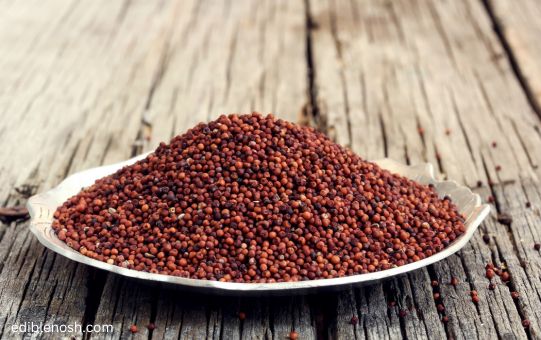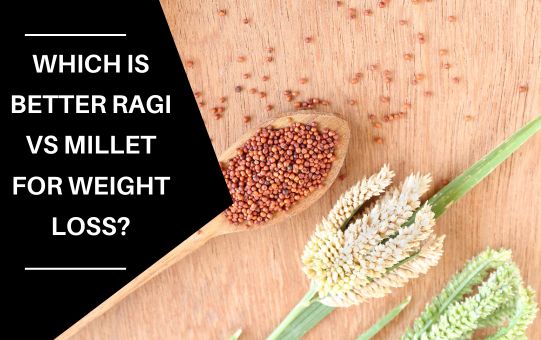If you are struggling to decide which is better ragi vs millet for weight loss? This comprehensive article compares the benefits, nutritional values, and weight loss potentials of ragi and millet.
Which is better ragi vs millet for weight loss? When it comes to weight loss, finding the right diet and choosing the best foods can be quite challenging. Among the many options available, ragi and millet have gained popularity as healthy alternatives to traditional grains.
Although both ragi and millet offer several nutritional benefits, to find more suitable for weight loss keep reading this article. Here you get the information about the properties of ragi and millet to determine which grain holds the upper hand in the battle for weight loss supremacy.
Contents
Ragi: The Wonder Grain
Ragi, also known as finger millet, is a widely consumed grain in many parts of the world, especially in Asia and Africa. Let’s explore why ragi is often considered a nutritional powerhouse.
Rich in Fiber and Low in Calories
Ragi is an excellent source of dietary fiber, which aids in digestion and helps maintain a feeling of fullness. This grain is also low in calories, making it a suitable choice for those looking to shed pounds.
Packed with Essential Nutrients
Ragi is a rich source of essential nutrients such as calcium, iron, and vitamin D. These nutrients play a vital role in maintaining bone health and boosting the immune system.
Gluten-Free Option
For individuals with gluten sensitivities or celiac disease, ragi offers a gluten-free alternative. This makes ragi a versatile choice for those following a gluten-free diet.

Millet: The Nutrient-Dense Grain
Millet, on the other hand, is a versatile grain that comes in various forms, including pearl millet, foxtail millet, and sorghum. Let’s explore why millet is gaining recognition as a nutritious grain with potential weight loss benefits.
High Protein Content
Millet is known for its high protein content, making it an excellent choice for individuals aiming to build lean muscle mass. Protein plays a crucial role in weight loss by promoting satiety and preserving muscle tissue.
Complex Carbohydrates for Sustained Energy
Millet is a complex carbohydrate that provides sustained energy throughout the day. This steady release of energy can prevent energy crashes and keep you feeling fuller for longer periods, reducing the likelihood of overeating.
Abundant in Antioxidants
Millet contains a range of antioxidants, such as phenolic compounds, which help fight free radicals and reduce oxidative stress in the body. Antioxidants are known for their potential to support weight loss and overall health.
Read Also>>>What is the difference between millet vs sorghum taste?
Which is Better Ragi vs. Millet for Weight Loss?
Now that we have explored the individual benefits of ragi and millet, let’s compare them head-to-head to determine which grain is more suitable for weight loss.
Nutritional Profile Comparison
| Nutrients (per 100g) | Ragi | Millet |
| Calories | 336 | 378 |
| Protein | 7.3g | 11g |
| Dietary Fiber | 3.9g | 8.5g |
| Carbohydrates | 72g | 72g |
| Fat | 1.3g | 4g |
| Calcium | 344mg | 8mg |
| Iron | 3.9mg | 3.9mg |
| Vitamin D | 0mcg | 0mcg |
From the nutritional profile comparison, it’s evident that both ragi and millet offer valuable nutrients. Ragi is lower in calories, while millet boasts higher protein content and dietary fiber.
Weight Loss Potential
Both ragi and millet can contribute to weight loss due to their high fiber content, which promotes satiety and helps control overeating. However, millet’s higher protein content can further enhance weight loss efforts by preserving muscle mass and boosting metabolism.
Glycemic Index and Blood Sugar Regulation
Ragi has a low glycemic index, meaning it releases glucose slowly into the bloodstream, preventing sudden spikes in blood sugar levels. Millet, on the other hand, has a moderate glycemic index. While both grains can help regulate blood sugar levels, ragi may be more suitable for individuals with diabetes or insulin resistance.
Versatility and Taste
Ragi can be consumed in various forms, including flour, flakes, and porridge. It has a slightly nutty flavor, which may take some getting used to for those accustomed to other grains. Millet, on the other hand, has a milder flavor and can be used in a variety of dishes, such as salads, soups, and pilafs.

Conclusion
When it comes to weight loss, ragi and millet both have their merits. Ragi’s low-calorie and high-fiber content make it an excellent choice for those looking to reduce their caloric intake.
Millet, on the other hand, stands out with its high protein content and sustained energy release.
Read Also>>>what is difference in nutrition millet vs brown rice?
FAQs About Ragi and Millet for Weight Loss
Can ragi or millet alone help me lose weight?
While ragi and millet offer several weight loss benefits, it’s important to note that no single food can guarantee weight loss. A balanced diet, regular physical activity, and portion control are essential for achieving sustainable weight loss.
Can I consume ragi or millet if I have gluten sensitivities?
Yes, both ragi and millet are gluten-free grains, making them suitable options for individuals with gluten sensitivities or celiac disease.
Can I substitute ragi or millet for other grains in my diet?
Absolutely! Ragi and millet can be used as alternatives to other grains in various recipes. Experimenting with different grains can add variety to your diet and potentially aid in weight loss.
Are there any side effects of consuming ragi or millet?
Ragi and millet are generally safe to consume. However, it’s essential to listen to your body and consult a healthcare professional if you experience any adverse reactions or allergies.
How can I incorporate ragi or millet into my diet?
Ragi and millet can be consumed in the form of porridge, or flour, or incorporated into dishes like rotis, pancakes, and soups. There are numerous recipes available online that provide creative and delicious ways to include ragi and millet in your diet.

